Chapter 17.44
COMMERCIAL AND MIXED USE ARCHITECTURAL AND SITE DESIGN STANDARDS
Sections:
17.44.030 Process information.
17.44.050 Maximum building setback from primary street frontage.
17.44.070 Gateway Forest Corridor.
17.44.090 Off-street parking lots.
17.44.110 Pedestrian- and bicycle-friendly commercial development.
17.44.120 Commercial development adjacent to residential zones.
17.44.130 Building design, materials, and colors.
17.44.010 Purpose and intent.
The general purposes of the commercial and mixed use design standards are as follows:
A. To help implement the city of Port Townsend’s:
1. Comprehensive plan;
2. Gateway development plan; and
3. Nonmotorized transportation plan;
B. Promote development in the city’s commercial and mixed use zones that is compatible with the historic character and pedestrian orientation of Port Townsend, encouraging and requiring commercial development that enables the safe circulation of pedestrians with minimal vehicle-pedestrian conflicts, softens the auto-dominated nature of the zoning district, and provides a regional design, which invites the pedestrian into ground floor commercial establishments;
C. Enrich the quality of the commercial and mixed use zones’ built and natural environment;
D. Foster development that is compatible with and implements the city’s “community direction statement,” Chapter III of the comprehensive plan;
E. Promote distinct communities and senses of place that strengthen the commercial and mixed use districts as commercial service destinations for Port Townsend’s residents and visitors;
F. Provide clear directions to public and private decision makers regarding the city’s property development expectations; and
G. Require building design that is compatible with adopted requirements, while allowing design professionals guidance that is flexible and encourages creative solutions. (Ord. 2840 § 2(Exh. A), 2003).
17.44.030 Process information.
For preapplication process, applicability, application process, notice requirements, permit review process, alternative designs, and other process information, see Chapter 17.46 PTMC. (Ord. 2840 § 2(Exh. A), 2003).
17.44.040 Commercial and mixed use short plats, subdivisions, and binding site plans – Block sizes, building separation and street layout.
A. Objective. New or modified commercial or mixed use short plats, subdivisions, and binding site plans or new commercial or mixed use developments shall be designed to provide safe and convenient vehicle, nonmotorized, and pedestrian access to individual lots and building sites. All lots, blocks, and building sites shall be configured to be compatible with the size, shape, and patterns of Port Townsend streets and blocks established in the late 1800s, including separation of blocks by street rights-of-way, while giving consideration to unusual pre-existing property dimensions, topography, and landscape buffer requirements.
1. The maximum size for blocks in new or modified plats or binding site plans, or for building sites on undivided land, shall not exceed 40,000 square feet.
2. Each block or building site shall be separated from other blocks or building sites by a public right-of-way or public access easement so as to be surrounded on all sides by such right-of-way or access easement.
3. The standard Port Townsend commercial block is square. However, new blocks or building sites may vary in dimension (up to a maximum size of 40,000 square feet) to allow for interior alleys or rectangular, triangular, or other geometric shapes as necessary.
4. For purposes of this section, a “block” shall mean a group of lots, tracts or parcels within well-defined and fixed boundaries surrounded by public rights-of-way or easements.
5. In the C-I, C-II, and C-II(H) general commercial zoning district, multiple structures on a single property reviewed as a single development proposal, or built in phases, may not be attached to exceed 40,000 square feet of ground floor area. Such multiple structures must be separated by at least 60 feet when their combined ground floor area exceeds 40,000 square feet. Reductions in building separation may be considered through a departure when the space in between the buildings will be used for pedestrian and emergency vehicle access only (i.e., not open to daily vehicle traffic). (Ord. 2920 § 17, 2005).
17.44.050 Maximum building setback from primary street frontage.
A. Objective. Buildings shall be oriented towards the primary street frontage and public paths and/or sidewalks. Buildings on corner lots should be oriented towards the primary intersection.
1. Where properties front one or more streets, new buildings shall be located no more than 25 feet from the primary street frontage.
Illustration No. 1: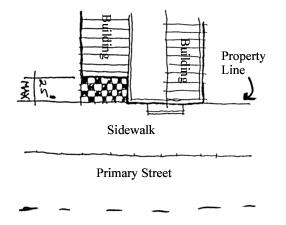
a. Exception: This maximum front yard setback does not apply where a property fronts on Sims Way or Discovery Road in the “forest corridor” as defined in PTMC 17.44.070. In those areas a vegetative buffer of existing trees and/or infill plantings will screen all or a portion of a commercial site from Sims Way.
b. Exception: Accessory and secondary buildings need not comply with the maximum setback standards where a primary building occupies the available street frontage.
2. Buildings on corner lots should be oriented toward the primary intersection and the primary and secondary street frontages, while parking and auto access shall be located away from the primary intersection corners.
Illustration No. 2: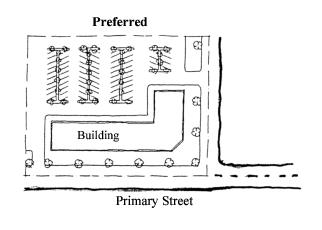
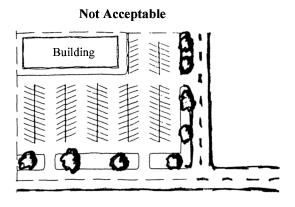
a. The use of lot corner entrances, plazas, signage, and/or landscaping is encouraged to accentuate corner sites.
Illustration No. 3: 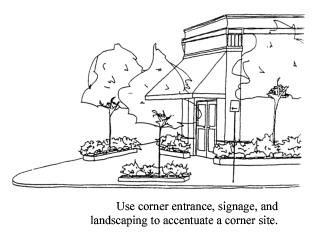
B. Objective. Where buildings are separated from the public sidewalk along the primary street frontage, the space should contain public and pedestrian amenities.
1. Buildings may be separated from the sidewalk by plazas, landscaping, benches, bicycle racks, trash cans, and other pedestrian amenities.
Illustration No. 4: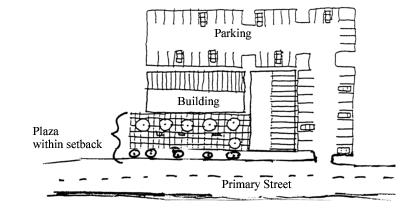
(Ord. 2840 § 2(Exh. A), 2003).
17.44.060 Topography.
A. Objective. Existing trees, topography and other existing natural features shall be incorporated into the project design.
1. To the extent reasonable and practicable incorporate natural grades into the overall site plan.
a. Incorporate natural features such as large rocks or boulders into landscaping design. (Ord. 2840 § 2(Exh. A), 2003).
17.44.070 Gateway Forest Corridor.
Objective: As the two main entrances to Port Townsend, Sims Way and Discovery Road, have historically appeared as forested corridors, new development in the Gateway Forest Corridor (as identified in the 1991 Gateway Development Plan) shall preserve this character to the extent possible.
A. Along Sims Way from the intersection of Mill Road to a point 300 feet west of Howard Street, preserve all native vegetation to a minimum depth of 50 feet. Vegetation in the Sims Way right-of-way may not be counted towards this natural buffer.
1. On-site trees in the 50-foot buffer may be counted towards landscaping and tree retention requirements in PTMC 17.72.190 and Chapter 19.06 PTMC.
2. Native vegetation in the forest corridor buffer may be removed only for approved driveways onto Sims Way, utility corridors, or pedestrian pathways.
B. Along Discovery Road from the intersection of Mill Road to the intersection of Howard Street, native trees (minimum six-inch dbh) and other existing vegetation should be preserved to the extent possible. Such retention is the strongly preferred method of fulfilling landscaping and tree conservation provisions of PTMC 17.72.190 and Chapter 19.06 PTMC. However, on-site development need not be totally visually screened from Discovery Road. (Ord. 2840 § 2(Exh. A), 2003).
17.44.080 Landscaping.
A. Objective. Landscaping shall be incorporated into new development design to soften the manmade environment, provide vegetative buffers, open space, and mitigate any unavoidable loss of existing native vegetation. The preferred method of landscaping is to first incorporate and preserve existing trees and shrubs, topography and other existing natural features into the project design. Any unavoidable loss of existing native vegetation shall be mitigated.
1. All proposals must comply with the tree retention standards of Chapter 19.06 PTMC, Tree Conservation.
2. Landscaping in parking lots shall conform to requirements of PTMC 17.72.190 and Chapter 19.06 PTMC.
3. Landscaping techniques including living plant material and supporting elements shall include, but are not limited to, the following:
a. Landscape open areas created by building modulation.
b. Retain natural vegetation and undisturbed open space.
c. Use plants that require low amounts of water, including native drought-resistant species.
d. Locate trees on storefront street frontages at appropriate spacing so that at maturity building signage and entrance are clearly visible from the street and sidewalk.
e. Plant a mix of evergreen and deciduous plants to maintain year-round color and interest.
f. Incorporate on-site natural objects such as rocks, boulders and tree stumps into landscape design where possible.
g. Shrubs, grasses and other nontree vegetation shall be included in the plan as appropriate to the site on a case-by-case basis.
4. An irrigation method shall be included in the landscaping plan. Irrigation shall be required immediately after planting and May through October thereafter or as recommended by a landscape professional. Developers should consider installing underground irrigation systems whenever possible to avoid drought loss.
5. When used, detention ponds and bioswales shall be incorporated into the project landscaping using plants and irrigation recommended by a professional familiar with such projects.
B. Optional landscaping techniques may also include where appropriate:
1. Providing frameworks such as trellises or arbors for plants;
2. Incorporating planter guards, retaining walls, or low planter walls as part of the architecture;
3. Incorporating upper story planter boxes, ‘green roofs,’ roof gardens or plants;
4. Incorporating outdoor furniture into the landscaping plan.
C. The director may consider a waiver of certain landscaping requirements if significant existing (especially native) vegetation and topography are preserved. (Ord. 2840 § 2(Exh. A), 2003).
17.44.090 Off-street parking lots.
A. Objective. Development shall minimize the impact of parking on the building’s relationship to the street and pedestrian-oriented character and character of the neighborhood.
1. Off-street parking shall be located to the side or rear of buildings. (Waterside properties see subsection (A)(4) of this section.)
2. Parking lots shall not be located between the building and the primary street frontage.
3. Off-street parking shall occupy no more than 30 percent of the primary street frontage nor more than 75 percent of any secondary street frontage for corner lots.
4. In the event that a building is located on a waterfront lot, parking shall be located to the side of the building, and not between the building and the water.
5. Adjacent developments are encouraged to link parking areas and access ways in order to encourage combining of shopping trips and pedestrian activity and to reduce redundant driveways.
6. Low impact development techniques for stormwater management should be used wherever possible.
Illustration No. 5: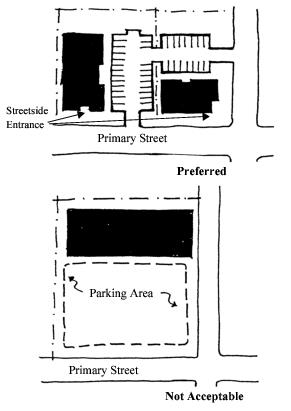
(Ord. 2840 § 2(Exh. A), 2003).
17.44.100 On-street parking.
A. Objective. On-street parking is encouraged along the streets, access drives, and alleys in order to provide convenient access and reduce the need for off-street parking lots.
1. The required number of off-street parking spaces shall be reduced by two spaces for each developed on-street parking space pursuant to PTMC 17.72.120(C). For projects located in R-IV, C-I/MU, C-II/MU, and M/C(S) zones, the required number of off-street parking spaces shall be reduced by three spaces for each developed on-street parking space.
2. Allow use of on-street parking for Americans with Disabilities Act (ADA) requirements if such a location meets ADA design standards and would better serve the public than off-street ADA parking.
Illustration No. 6: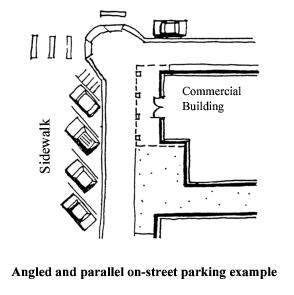
(Ord. 3323 § 1 (Exh. M), 2023; Ord. 2920 § 7, 2005; Ord. 2840 § 2(Exh. A), 2003).
17.44.110 Pedestrian- and bicycle-friendly commercial development.
A. Objective. Provide safe, bicycle and pedestrian-friendly development.
1. Walkways shall be provided between the primary abutting street and the main pedestrian entrances to buildings.
2. The interruption of sidewalks by driveways should be minimized. Where driveways cross sidewalks, the sidewalks should remain raised with a curb cut and ramp over the sidewalk provided so cars may pass over the sidewalk rather than requiring pedestrians to step down to an interrupting driveway.
3. Pedestrian access shall be provided between commercial sites and adjacent areas. Existing informal pathway locations and future walkway locations shown in the nonmotorized transportation plan shall be taken into consideration when locating new paths.
4. Bicycle locking racks that support the entire bicycle frame, not just the front wheel, shall be provided. Bicycle racks shall be located as closely as possible to primary building entrances (generally within 20 feet) and shall be lit during evening business hours per PTMC 17.44.180. New buildings should provide covered bicycle racks, especially those used by employees.
Illustration No. 7: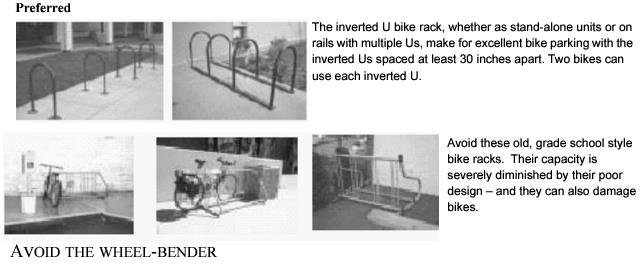
B. Objective. Provide safe walkways for pedestrians through off-street parking lots and from adjacent streets and properties.
1. Pedestrian walkways in off-street parking lots shall be physically separated from vehicle travel lanes. In large parking lots with parallel multiple parking lanes, pedestrian walkways shall be provided between the parking stalls.
2. Pedestrian crossings should be short and well marked.
3. In large parking lots with multiple parallel rows of parking, direct primary vehicle traffic away from the building entrance; any traffic lanes adjacent to the building should be preserved primarily for emergency vehicle and pedestrian access to the building.
Illustration No. 8: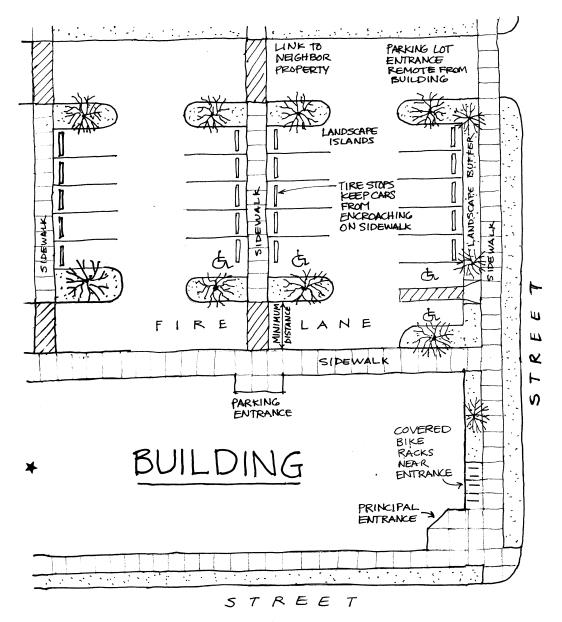
(Ord. 2840 § 2(Exh. A), 2003).
17.44.120 Commercial development adjacent to residential zones.
A. Objective. Buildings shall be designed to ensure that building massing, height, and scale provide sensitive transition to adjoining residential neighborhoods. When abutting an R-I, R-II or R-III zoning district, the project’s landscaping plan must include provisions for vegetative screening between the project and the residential property.
1. New developments whose bulk and scale may negatively impact adjacent residential areas shall mitigate the effect through careful site planning and architectural design. Possible mitigation techniques include, but are not limited to, the following:
a. Locating open space and preserving existing vegetation on the site’s edge to further separate the building from less intensive uses;
b. Stepping down the massing of the building along the site’s edge;
c. Limiting the length of or articulating building facades to reflect adjacent residential patterns; and
d. Creative use and ongoing maintenance of landscaping, such as berms, mounds, rockeries, living fences, and swales. The landscape plan shall include a greenbelt, at least an eight-foot-wide buffer to create a year-round visual screen of at least six feet in height. The buffer should be designed to avoid the appearance of a straight line or ‘wall’ of uniform plant material, and shall be wide enough to accommodate the planted species at maturation.
Illustration No. 9: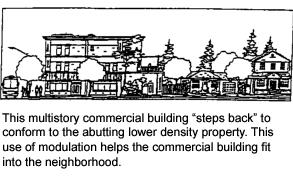
(Ord. 2840 § 2(Exh. A), 2003).
17.44.130 Building design, materials, and colors.
A. Objective. New development should recognize the city’s historic architectural heritage through the use of building materials and proportions compatible with those design principles inherent in historic architecture without replicating historical buildings.
1. Roof Design.
a. Roof design shall reduce the mass and scale of buildings, add visual interest and prevent reflective glare. Flat roofs shall have parapets to conceal the roof and mechanical equipment from ground level views. Sloping roofs shall have three or more roof planes.
b. When designing rooftops visible from hillsides, special attention shall be given to prevention of reflective glare and placement/design of mechanical equipment. Roof gardens or “living roofs” may be considered and are encouraged.
2. Overhanging eaves are encouraged on sloped roofs.
3. Exterior siding consisting of wood, brick, and/or other materials with “natural” textures is encouraged. The use of recycled and “ecologically friendly” materials is also encouraged.
4. Exterior building materials shall be of similar type (e.g., wood or masonry) on all sides of a building, except that embellishments and details proposed for the street side frontage(s) of the building need not be carried through on other sides.
5. Exterior walls shall not be constructed of tilt-up concrete.
6. Building colors should be compatible with other buildings as well as natural and topographic features in the vicinity. The use of colors that emphasize earth tones typical of the Port Townsend area or those selected from the historic preservation committee’s color palette of tertiary colors are encouraged. Bright colors should be minimized or used for minor architectural accents rather than on major portions of the building.
7. Building fascias shall not be used as sign platforms.
8. Departures From the Sign Code Maximum Height Limit for Signs in the C-I, C-II, and C-II(H) Zones to Exceed 17-Foot Height Limit. In reviewing such departure requests the committee shall recognize that signs should generally be pedestrian-oriented, but that in some cases good design may call for taller signage. All signage otherwise shall conform to the provisions of Chapter 17.76 PTMC.
9. Buildings should be provided with a distinct “base” through the use of materials, texture, or massing.
10. Towers of up to 100 square feet in plan view, which exceed the height limit of the applicable zoning district by up to 10 feet, may be considered and approved through the departure process.
Illustration No. 11: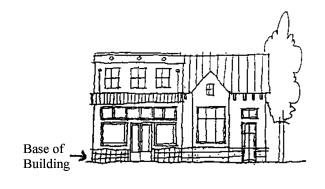
11. Multistory buildings are strongly encouraged. Residential development is permitted outright on upper floors and is encouraged.
12. When buildings include residences on upper floors, rooftop gardens and upper floor terraces and decks are encouraged and may partially fulfill landscaping requirements.
13. Walls shall appear to be composed of relatively small increments. No wall segment on a street frontage shall be longer than 30 feet. Walls may be articulated in two or more of the following ways:
a. Reveals;
b. Recesses (at least two feet in depth or five percent of wall length whichever is larger);
c. Offsets;
d. Overhangs, porches and covered walkways;
e. Providing window and door openings with substantial trim elements;
f. Projecting bays or upper floors;
g. Stepped back upper floors;
h. Changes in roof form;
i. Changes in materials;
j. Permanently installed and maintained trellises or vegetation.
14. New development should locate windows, skylights, open spaces, and decks to take advantage of southern exposure. Buildings and canopies should be designed to utilize natural light to reduce energy costs.
15. Building placement and design shall consider shadow impacts to adjacent properties and minimize these impacts to the extent reasonable and practicable. For example, where building features are nonfunctional or decorative (parapets, unused attic space) such features should be reduced in scale where shadowing of adjacent properties will occur. (Ord. 2920 § 2, 2005; Ord. 2840 § 2(Exh. A), 2003).
17.44.140 Vehicle canopies.
A. Objective. Freestanding or attached vehicle canopies and porte cocheres associated with gas stations, convenience stores, or drive-throughs shall function as structures rather than signs. Vehicle canopies shall not function as sign platforms.
1. Vehicle canopies are structures and are subject to the building design, materials, and color criteria of PTMC 17.44.130. Canopies shall follow the colors, material and design used on primary building(s). Canopy design should reflect the architectural design of the primary buildings.
2. The purpose of vehicle canopies is to provide weather protection, not to provide an elevated sign platform. No signs other than directional signs may be erected on canopy structures; directional signs shall be mounted no higher than 10 feet above grade. Signs shall meet all the provisions of Chapter 17.76 PTMC.
3. Vehicle canopies shall have a minimum roof pitch of 3/12 and display the underside of the roof structure. Skylights are encouraged.
4. Clearance under canopies shall not exceed 14 feet, seven inches.
Illustration No. 12: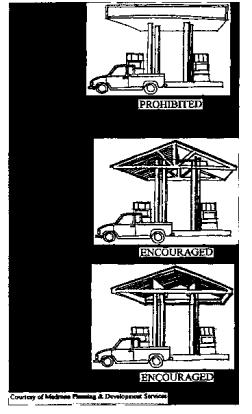
(Ord. 2840 § 2(Exh. A), 2003).
17.44.150 Building entrances.
A. Objective. The primary entrances of buildings shall be identified and highlighted through architectural details, lighting, and signage. The design of buildings shall enhance the relationship between buildings and streets by creating easily identifiable building entrances.
1. Entrances shall be visible from the adjoining primary street.
2. Techniques that may be used to highlight primary building entrances include, but are not limited to, the following:
a. Recessed entry;
b. Glazed door;
c. Roof line emphasis;
d. Windows above entry;
e. Projecting sign above doorway, subject to sign code;
f. Canopy, marquee, or awning above entry;
g. Head molding or decorative lintel above doorway;
h. Contrasting, decorative finish materials;
i. Street address posted prominently above or near the building entrance.
Illustration No. 13: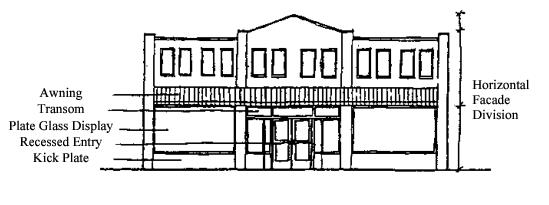
(Ord. 2840 § 2(Exh. A), 2003).
17.44.160 Weather protection.
A. Objective. Buildings should provide protection for pedestrians from adverse weather conditions.
1. Overhangs, marquees, and awnings that provide protection for pedestrians and bicycle racks from adverse weather conditions should be incorporated at entrances, along pedestrian pathways, and at transportation waiting areas.
Illustration No. 14: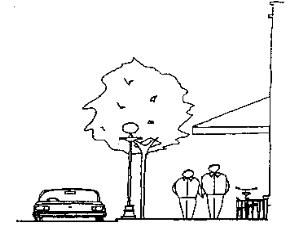
2. Port Townsend often experiences strong wind conditions. Doorways should be oriented or sheltered so that doors can be opened easily and safely when strong seasonal winds are present. (Ord. 2840 § 2(Exh. A), 2003).
17.44.170 Transparency.
A. Objective. Buildings shall provide generous amounts of windows to create ground floors with a “transparent” quality in order to provide visual interest.
1. Windows shall cover at least 30 percent of the facade area (as measured from grade to eight feet above grade) facing the primary street and also the secondary street on corner lots. The standard shall be applied to each individual street facade. Windows are also encouraged on upper floors.
2. Windows shall not consist of reflective glass.
3. Windows should begin at least 12 inches above grade rather than continue down to grade level. (Ord. 2840 § 2(Exh. A), 2003).
17.44.180 Lighting.
A. Objective. All exterior lighting, including that used to illuminate signs, shall be designed to reduce glare impacts to adjacent properties and public rights-of-way, to use energy efficiently, and to reduce nighttime “light pollution.”
1. An exterior lighting plan shall be included with the design review application pursuant to the requirements of PTMC 17.46.040.
2. a. All exterior lighting, including that to illuminate signs, shall be pointed downward and shielded from direct observation from the air, adjacent properties, and public rights-of-way. Lighting “spillover” to adjacent properties shall be minimized. Lamps shall use recessed or flat lenses. Light fixtures, shall be “full cutoff” fixtures as defined by the Illuminating Engineering Society of North America.
b. Alternative. If use of fixtures which do not meet the “full cutoff” definition are proposed, other fixtures may be used if it is determined by the PCD director that no significant light pollution or trespass will result and if the maximum initial lumens generated by each fixture does not exceed 1,500 lumens in total (approximately equivalent to an 18-watt compact fluorescent or 100-watt incandescent bulb).
3. Lighting in exterior canopies shall be recessed so that the lens does not drop below the level of the canopy.
4. Exterior light poles shall not exceed a height of 17 feet above grade, including the base.
5. When lighting is used for security, the use of motion sensors and/or timers is required.
6. Exterior lighting shall be limited to nighttime business hours only. Lighting shall be located near the activity needing illumination. Walkways, entrances, and parking areas may be lit during nighttime business hours, but such lighting shall be the minimum necessary for safety. Lighting in parking lots should be of uniform intensity, since the eye cannot easily adapt to areas of darkness and brightness in proximity to one another.
7. Buildings shall not be outlined with neon or other lighting, except seasonal lighting.
8. If, once installed, lighting is found to be performing in violation of these standards, the city may require the business owner to take corrective action to bring the lighting into compliance.
9. Lighting shall be maintained to meet these standards at all times.
10. Nighttime lighting of the American flag is exempt from the provisions of this chapter, except that such lighting shall not provide direct glare to neighboring properties or traffic.
Illustration No. 15: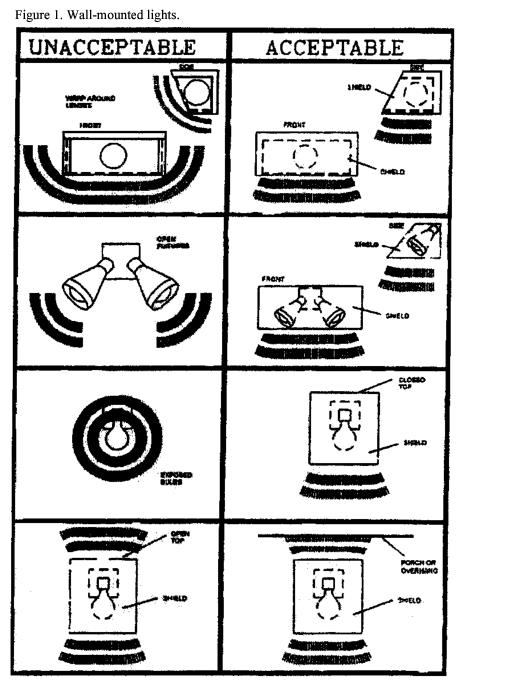
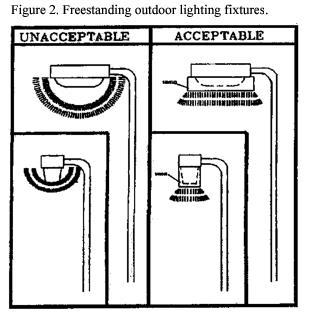
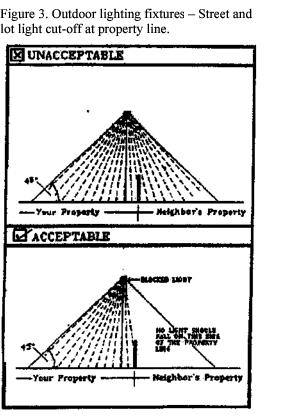
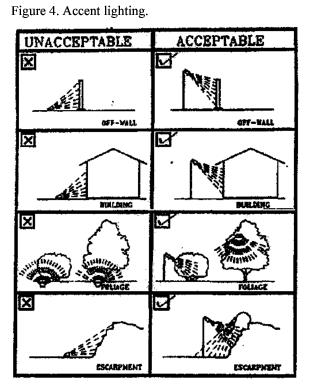 (Ord. 3287 § 5, 2022; Ord. 2892 § 1, 2005; Ord. 2840 § 2(Exh. A), 2003).
(Ord. 3287 § 5, 2022; Ord. 2892 § 1, 2005; Ord. 2840 § 2(Exh. A), 2003).
17.44.190 Support elements.
A. Objective. Mechanical elements, loading areas, trash, and recycling containers shall be located and/or screened to minimize their visibility from public view.
1. Refuse and storage containers shall be screened with built and/or landscaped confinements.
2. Refuse and storage areas should be located to the rear or side of the property and away from adjacent streets and residential property.
3. Service and loading areas should be located to the rear or sides of buildings away from adjacent streets but shall be designed for convenient use.
4. On waterfront buildings, support facilities should not be located between the building and the water but rather should be located to the side of the building.
5. Rooftop mechanical equipment shall be concealed from view by a roof form integrated with the overall architecture of the building, either by locating the equipment within the structure or concealing it from ground level view behind a parapet.
6. Views of rooftop equipment from nearby hillsides shall be minimized.
7. Other outdoor mechanical equipment (such as ground-mounted heat pumps and wall-ducted exhaust vents) and electrical service equipment (meter boxes, service lines, etc.) shall be integrated with the overall architecture of the building or screened from ground-level view. (Ord. 2920 § 13, 2005; Ord. 2840 § 2(Exh. A), 2003).


